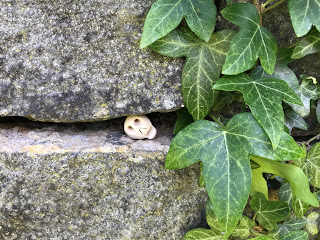I had never been to Glasgow Necropolis before this visit. It’s one of these places I’ve always meant to go to, but for some reason I’d assumed it was miles out of Glasgow City Centre. It is not. It is only about a twenty-five minute walk from Queen Street Railway Station. So, after deciding that I had to explore more of Glasgow, I made my way up there. On reaching Glasgow Cathedral I crossed over the Bridge of Sighs, so called because of the countless number of funeral processions that crossed over it, and made my way over into the cemetery.
The
graveyard is quite spectacular with its huge monuments to many eminent
Victorians, most of whom no-one remembers now.
Such is the way; we are all soon forgotten. In a hundred years from now only a handful of
us will be remembered and most of us won’t even merit a footnote in the history
books written about our era…but I digress.
On
my wanders around I passed a memorial to William Miller. The name meant nothing to me, but the
inscription enlightened me that he was the author of Wee Willie Winkie and that
is a nursery rhyme that I, along with many others, remember from our
childhood. Well, the first verse anyway,
I don’t think the nursery rhymes books I had went any further than that verse,
which went –
Wee Willie Winkie runs through
the town,
Upstairs and downstairs in his
night-gown,
Rapping at the window, crying
through the lock,
Are the children all in bed,
for now it’s eight o’clock?
This
is actually a pretty anglicised version compared to the original, which also gives
the children’s bedtime as being a bit later, but then maybe the kids in
Victorian era Glasgow got to stay up late, who knows? Anyway, it goes -
Wee Willie Winkie rins through
the town,
Up stairs and doon stairs in
his nicht-gown,
Tirling at the window, crying
at the lock,
Are the weans in their bed,
for it’s now ten o’clock?
As
a child I always thought this rhyme was about a flasher. I assume because Willie and Winkie were two
words that I knew as meaning penis. Also,
because in the nursery rhymes book I had, Willie Winkie was depicted in his
long night gown and flashers, we were always told, wore long raincoats, so the
two somehow became intertwined. Ah,
those innocent days back in the 1970s.
I
then made my way round and up to the top of the hill. It is here that one can find some of the more
spectacular monuments in the Necropolis, along with the most Glaswegian looking
Jesus I’ve ever seen.
Burial
place of Isaac and Mary Blackwood
Glasgow
Necropolis stands in an area of land that was originally called Craig’s Park,
but which after being planted with Fir trees in the 1700s was then called (roll
of drums) Fir Park. The statue of John
Knox, at the top of the hill, was erected in 1825, prior to the area becoming a
cemetery. Glasgow Necropolis was
officially opened in 1833 as a place for public interment, though a small
Jewish Cemetery had been established in the lower grounds in 1832. Many of the
great and the good of Victorian Glasgow are buried here with ostentatious tombs
or gravestones marking their burial plots, though there are also several
thousand unmarked graves of the less well known or celebrated.
I
left the Skulferatu that accompanied me on today’s walk in a gap in a wall
overlooking the lower grounds of the Necropolis.
The
coordinates for the location of the Skulferatu are –
Latitude 55.863343
Longitude -4.232009
I
used the following sources for information on Glasgow Necropolis –
Sketches of Glasgow Necropolis
By George Blair
1857
The Peoples History of Glasgow
By John K McDowall
1899
The Oxford Dictionary of
Nursery Rhymes
Edited by Iona and Peter Opie
Oxford University Press
1992
Wikipedia – Glasgow Necropolis
Wikipedia
- Glasgow Necropolis
Article
and photographs are copyright of © Kevin Nosferatu, unless otherwise specified.



















